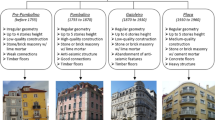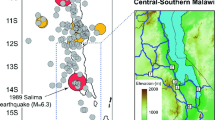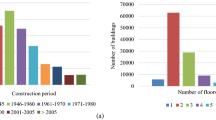Abstract
Improving the seismic resistance of traditional buildings is essential for preserving cultural heritage and increasing their safety. This is especially important for old masonry buildings in Lisbon (“Pombalino”, “Gaioleiro” and “Placa”), which are still used for housing and services. Taking this into account, this paper is focused on the seismic assessment of these three types of buildings. The buildings were modelled based on the equivalent frame model approach, their dynamic characteristics were determined and non-linear static (pushover) analyses were performed. Furthermore, for the seismic demand of Lisbon, the seismic performance of such building classes was defined and compared. Finally, with the aim of supporting seismic risk and loss estimation studies, a probabilistic assessment was carried out and the fragility curves for each building type derived.






















Similar content being viewed by others
References
3Muri Program, S.T.A.DATA s.r.l., release 5.0.4
American Society of Civil Engineers (ASCE) (2000) Pre-standard and commentary for the seismic rehabilitation of buildings. FEMA Publication 365, Federal Emergency Management Society, USA
Appleton J (2005) Rehabilitation of Gaioleiro buildings, 1st edn. Orion Editors, Lisbon (in Portuguese)
Cattari S, Lagomarsino S (2013) Seismic assessment of mixed masonry–reinforced concrete buildings by non-linear static analysis. Earthq Struct 4(3):241–264
European Committee for Standardization (CEN) (2004) Eurocode 8: design of structures for earthquake resistance—part 1: general rules, seismic actions and rules for buildings (EC8-1)
European Committee for Standardization (CEN) (2005) Eurocode 8: design of structures for earthquake resistance—part 3: assessment and retrofitting of buildings (EC8-3)
Fajfar P (1999) Capacity spectrum method based on inelastic demand spectra. Earthq Eng Struct Dyn 28(9):979–993. doi:10.1002/(SICI)1096-9845(199909)28:9<979:AID-EQE850>3.0.CO;2-1
Instituto Nacional de Estatísticas (INE – Portugal Statistics) (2011) Census 2011. Instituto Nacional de Estatísticas (INE—Portugal Statistics). http://www.ine.pt
Italian Code for Structural Design (Norme Tecniche per le Costruzioni – NTC) (2008) D.M. 14/1/2008, Official Bulletin Nº 29 of February 4, 2008 (in Italian)
Lagomarsino S, Cattari S (2014) Fragility functions of masonry buildings. In Pitilakis K, Crowley H, Kaynia A (eds) SYNER-G: typology definition and fragility functions for physical elements at seismic risk, buildings, lifelines, transportation networks and critical facilities series, vol 27. Geothechnical, Geological and Earthquake Engineering, pp 111–156. doi:10.1007/978-94-007-7872-6_5
Lagomarsino S, Cattari S (2015) PERPETUATE guidelines for seismic performance-based assessment of cultural heritage masonry structures. Bull Earthq Eng 13(1):13–47. doi:10.1007/s10518-014-9674-1
Lagomarsino S, Giovinazzi S (2006) Macroseismic and mechanical models for the vulnerability assessment of current buildings. Bull Earthq Eng 4:415–443. doi:10.1007/s10518-006-9024-z
Lagomarsino S, Penna A, Galasco A, Cattari S (2012) TREMURI program: seismic analyses of 3D masonry buildings, Release 2.0. University of Genoa, Italy (mail to: tremuri@gmail.com)
Lagomarsino S, Penna A, Galasco A, Cattari S (2013) TREMURI program: an equivalent frame model for the nonlinear seismic analysis of masonry buildings. Eng Struct 56:1787–1799. doi:10.1016/j.engstruct.2013.08.002
Lopes M, Azevedo J (1997) Assessment of the seismic behaviour of a Lisbon masonry building. In: Proceedings of the 3rd seismology and seismic engineering meeting, Lisbon, Portugal (in Portuguese)
Lopes M, Meireles H, Cattari S, Bento R, Lagomarsino S (2014) Pombalino constructions: description and seismic assessment. In: Costa A, Guedes J, Varum H (eds) Structural rehabilitation of old buildings, building pathology and rehabilitationm, vol 2. Springer, Berlin. doi:10.1007/978-3-642-39686-1_7
Lourenço P, Mendes N, Ramos L, Oliveira D (2011) Analysis of masonry structures without box behaviour. Int J Archit Herit 5(4-5):369–382. doi:10.1080/15583058.2010.528824
Meireles H, Bento R, Cattari S, Lagomarsino S (2012) A hysteretic model for “frontal” walls in Pombalino buildings. Bull Earthq Eng 10(5):1481–1502. doi:10.1007/s10518-012-9360-0
Meireles H, Bento R, Cattari S, Lagomarsino S (2014) Seismic assessment and retrofitting of Pombalino buildings by pushover analyses. Earthq Struct 7(1):57–82. doi:10.12989/eas.2014.6.7.000
Mendes N, Lourenço P, Costa A (2014) Shaking table testing of an existing masonry building: assessment and improvement of the seismic performance. Earthq Eng Struct Dyn 43(2):247–266. doi:10.1002/eqe.2342
Milošević J, Gago A, Lopes M, Bento R (2013) Experimental assessment of shear strength parameters on rubble stone masonry specimens. Constr Build Mater 47:1372–1380. doi:10.1016/j.conbuildmat.2013.06.036
Milošević J, Bento R, Cattari S (2014) Seismic assessment of a “Placa” building in Lisbon. In: Proceedings of the 2nd European conference on earthquake engineering and seismology, Istanbul, Turkey
Monteiro M, Lopes M, Bento R (2005) Dynamic behaviour of Pombalino Quarter. In: Proceedings of the 250th Anniversary of the 1755 Lisbon Earthquake, Lisbon, Portugal
Moreira S, Oliveira D, Ramos L, Lourenço P, Fernandes R, Guerreiro J (2012) Experimental study on the seismic behaviour of masonry wall-to-floor connections. In: Proceedings of the 15th World conference on earthquake engineering, pp 32–92
Oliveira C (2004) Update of the data-base on fundamental frequencies of building structures, bridges, viaducts, pedestrian crossings based on in situ measuring. In: Proceedings of the 6th national meeting on seismology and earthquake engineering (Sísmica 2004), Aveiro, Portugal (in Portuguese)
Pagnini L, Vicente R, Lagomarsino S, Varum H (2011) A mechanical model for the seismic vulnerability assessment of old masonry buildings. Earthq Struct 2(1):25–42
Proença J, Gago A (2011) Seismic strengthening of school buildings, 1st edn. Parque Escolar, Lisbon
Santos S (1997) Tests on Pombalino Walls. Report Nº 15/97, Núcleo de Comportamento de Estruturas (NCE), Laboratório Nacional de Engenharia Civil (LNEC), Lisbon, Portugal (in Portuguese)
Sequeira A (1999) Characterization and assessment of the market related to maintenance and conservation of the architectural heritage. Report GEcORPA—Grémio do Património, Lisbon, Portugal (in Portuguese)
Silva V, Soares I (1997) Seismic vulnerability of the Gaioleiro buildings of Lisbon and possible measures to reduce it. In: Proceedings of the 3rd seismology and earthquake engineering meeting, Lisbon, Portugal (in Portuguese)
Simões A, Bento R, Cattari S, Lagomarsino S (2014a) Seismic performance-based assessment of “Gaioleiro” buildings. Eng Struct 80:486–500. doi:10.1016/j.engstruct.2014.09.025
Simões A, Bento R, Cattari S, Lagomarsino S (2014b) Seismic assessment of “Gaioleiro” buildings in Lisbon. In: Proceedings of the 9th international masonry conference, Guimarães, Portugal
Turnšek V, Sheppard P (1980) The shear and flexural resistance of masonry walls. In: Proceedings of the international research conference on earthquake engineering, Skopje, Macedonia, pp 517–573
Acknowledgments
The authors would like to acknowledge the financial support of the Portuguese Foundation for Science and Technology (Ministry of Science and Technology of the Republic of Portugal) through the Research Project PTDC/ECM/100872.
Author information
Authors and Affiliations
Corresponding author
Rights and permissions
About this article
Cite this article
Simões, A., Milošević, J., Meireles, H. et al. Fragility curves for old masonry building types in Lisbon. Bull Earthquake Eng 13, 3083–3105 (2015). https://doi.org/10.1007/s10518-015-9750-1
Received:
Accepted:
Published:
Issue Date:
DOI: https://doi.org/10.1007/s10518-015-9750-1




